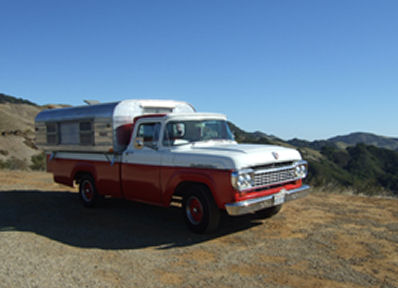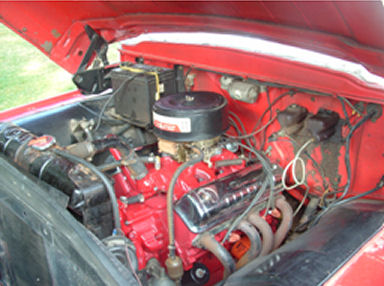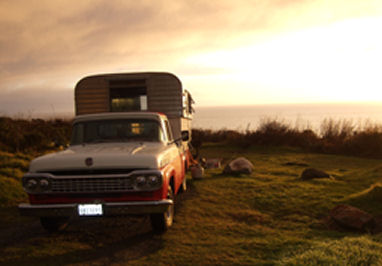| |
|
 Looking
For Sun Looking
For Sun
in
the ’58 F100
|
|
|
By Tim McMaster
|
| We
had seen nothing but fog, fog, fog for the week following
Christmas 2008 (a common problem for the San Joaquin Valley
in California during the winter months).
So my wife Kathy and I decided to load the Alaskan
pop top camper onto our ’58 Ford F100 pickup and head to
the coast for a change in scenery and sunshine. |
 |
First
of all this requires a tire change from the speed rated
Firestones to the taller tougher 8-ply Goodyears to handle
the extra load of the 1900 pound 10 foot camper.
Then off to the storage area to pick up the Alaskan.
Loading the Alaskan camper onto the truck is a tricky
process. Unlike modern campers with jacks mounted on the
four corners the Alaskan is a bit of a balancing act using
three cable style winches, one on each side and one at the
rear to adjust the “angle of attack”.
These winches have a support that consists of a one
and a half foot piece of one inch angle iron that supports
the edge just under the camper.
Once the camper is in the air it is a very unstable
affair to try to back the truck underneath it. |
| It is
best done with two people, one to back up the truck and the
other to guide it under.
It’s a tight fit but it’s on!
New
Year’s day 2009, we awoke to another day of the dreaded
Tule fog, but today would be different as we loaded our 3
dogs and got prepared to head west.
Switch on, four pumps of the gas peddle, and the 312
sprang to life with an eagerness so common to our beloved
Y-block. After a
few minutes of warm up we were on the road.
Out on the open highway the Y-block was humming along
at 2,200 rpm with an indicated speed of 60 mph (with a
taller 8-ply tires the speedometer reads 10% off ie. 50=55,
60=66, etc.) The
312 really likes this speed as it rides in a very
comfortable point of the power band. |
| This
particular “Y” is a 292 block bored +.060” over
(3.810”) with cast pistons, 312 ECZ connecting rods and
balanced ECZ crankshaft with the main journals ground to
2.498” to fit the 292 block.
With the 3.438 stroke this engine has a total of
313ci. On top of
the block are a set of ported ECZ-G posted cylinder heads
and have stainless 2.02” intake and 1.6” exhaust valves.
The valves are open by an Oregon Cams reground
camshaft with .309” cam lift, .282° adv. dur. with 108°
lobe centers. From
there through a set of HD chrome moly pushrods the valves
are opened by a set of 1.43:1 rocker arms to give a total
valve opening of .441”.
All this put together makes for a nice performing
engine as a hotrod or a torquey load hauler. |
 |
| West
on Kansas Ave. out of Tulare County we turned south on
California SR 41 towards the Kettleman Hills.
As we climbed into the first of two ranges of hills
between us and the Pacific Ocean the fog still won’t let
up. But finally
as we approach the intersection of SR 41 and SR 46 a ray of
sunshine and then we break into a clear day.
This particular intersection was made famous on Sept.
30, 1955 when a 1950 Ford Tudor
driven by Donald Turnupseed of Porterville,
California turned north on SR 41 in front of a speeding
westbound Porsche 550 Spyder. Donald Turnupseed became
a successful businessman but for the rest of his life he was
known as the man who killed James Dean.
After
about an hour and twenty minutes on the road it was time for
us and our puppies to stretch our legs.
So we pulled into a highway rest stop near Shandon,
CA. SR 46 is a
main highway to the central coast and is very well traveled.
So without the advent of an On-ramp to accelerate,
when it came time to get back on the highway it was no
simple task. Car
after car, and truck after truck, there wasn’t any
opening. Finally
after what seemed eternity I saw my chance, but I knew it
was going to be tight. I
made a hard left turn in the heavy rig and lined up with the
highway. Down on
the gas peddle! The
312 climbed to 4,500 rpm quickly. Then
to second gear and back hard on the gas peddle.
The dual exhaust and four horns of the Holley
carburetor were making sweet music to my ears as the 312
climbed rapidly to 4,500 rpm once again.
Then with a quick shift to third gear and back to the
gas, we were doing 60 mph indicated
again. Once
we settled back into fifth gear on the T-5
I thought to myself, “for an old pick-up with a
1900+ pound load on the back, this 312 “Y” accelerates
pretty good.”
With
a turn to the south on US 101 in Paso Robles we traveled for
a couple miles where we picked up SR 46 again heading west
to Cambria through the beautiful central California wine
country. Climbing
some fairly steep hills in fourth gear at 55 mph we were
over the last coastal range where we could see the vast
expanses of the Pacific Ocean open up before us.
At the end of SR 46 we head north on the
beautiful Pacific Coast Highway, California SR 1 with waves
crashing against the rocky shoreline.
We drive through San Simeon then passed Hearst
Castle, proudly standing above William Randolph Hearst State
Beach. To our
right we see herds of zebras running wild that were left
over from Hearst’s private zoo.
After traveling about 5 miles of relatively
straight highway, the highway gets quite twisty, rising and
falling with hair-pin turns and up to 7% grades as we
proceed up the rocky cliffs towards our campground
destination. Mostly
low gear work. |
 |
This is where the torquey Y-block shined.
On one of these steep 7% grades I wanted to do a
little test. So
in third gear, at 25 mph and 1500 rpm, I eased down on the
gas peddle and the old ’58 F100 accelerated eagerly up the
hill. What a
fine machine! After
20 more miles of this coastal highway that reminded me of a
malaria germ, we finally came to Kirk Creek Campground.
As we pulled into campsite #11, over looking a sheer
drop of 100 feet to the churning water below, we watched as
the big red sun setting into the Pacific Ocean.
Getting there is always half the fun, but now we were
ready for 2 days of rest and relaxation in our 10 foot
pop-up Y-block powered beach cabin on wheels. |
|
|

